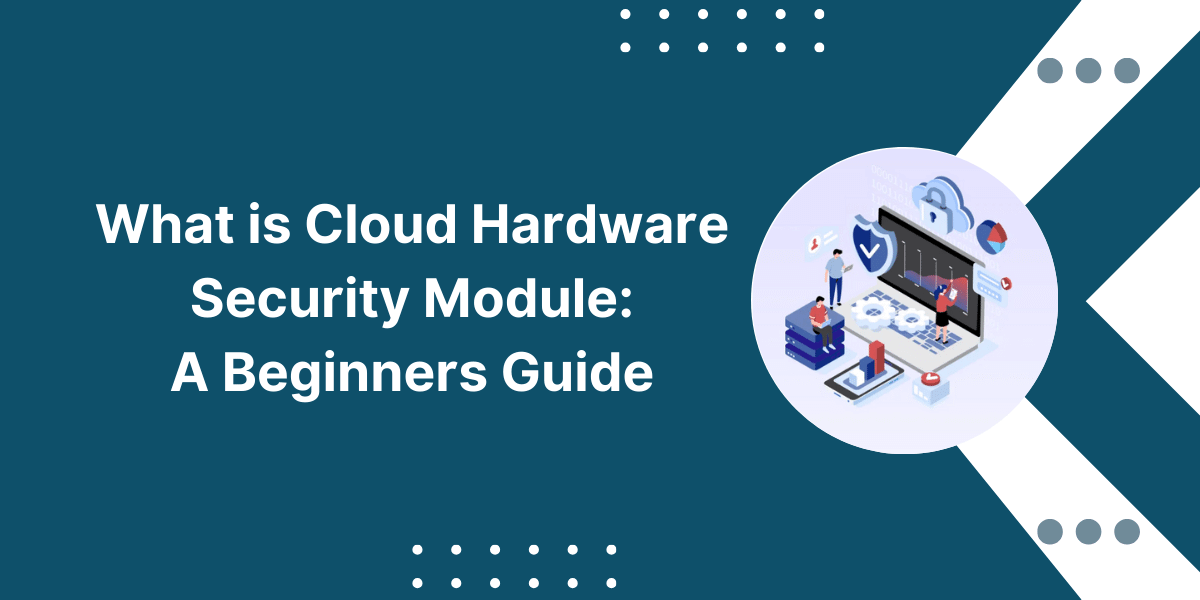Cloud Hardware Security Module; Meaning, Features, Pros & Cons
Data breaches and cyberattacks are on the rise globally, causing massive financial losses and reputation damage for organizations. To secure sensitive data like encryption keys, payment card information, intellectual property, and personal data, robust cryptographic security is essential. This is where hardware security modules (HSMs) come in. HSMs are dedicated cryptographic devices designed to safeguard and manage digital keys and perform cryptographic operations. Traditionally, HSMs were physical appliances installed on-premises. However, with the rapid adoption of cloud computing, there is a growing need for the cryptographic capabilities of HSMs to be available as cloud-based services. Cloud Hardware Security Module allows enterprises to protect their encryption keys and critical cryptographic operations within the cloud.
This article provides an in-depth overview of cloud Hardware Security Modules (HSMs): what they are, their benefits, factors to consider when selecting an HSM, leading providers, implementation, and management best practices, and more. Let’s get started.
Key Takeaways:
- A cloud hardware security module (HSM) is a physical computing device used to safeguard and manage digital keys and perform cryptographic operations in a cloud environment.
- Cloud HSMs provide robust protection for encryption keys, digital signatures, and cryptographic processing. They are tamper-resistant and offer hardened security through physical protection and logical controls.
- Benefits of using a cloud HSM include regulatory compliance, enhanced data security, high availability, scalability, and reduced total cost of ownership.
- When selecting a cloud HSM, key factors to consider are certification level, cryptographic support, cloud integration, scalability, high availability, and ease of management.
- Leading cloud HSM providers include AWS CloudHSM, Azure Dedicated HSM, Google Cloud HSM, IBM Cloud HSM, and Thales Cloud HSM. The choice depends on specific requirements.
- Proper cloud HSM implementation requires planning for redundancy, high availability, access controls, and disaster recovery. Ongoing tasks involve cryptographic operations, backups, audits, and system maintenance.
Getting Started with Cloud HSM
Here are some steps to help you get started with implementing cloud HSM:
- Identify business needs: Legal compliance, improved data security, higher application performance, etc.
- Define requirements: Cryptographic algorithms required, keys to be protected, integrations needed, redundancy expectations, etc.
- Evaluate provider options: AWS CloudHSM, Azure Dedicated HSM, IBM Cloud HSM, etc., based on offerings, pricing, and service capabilities.
- Start with a pilot: Provision cloud HSM instances on a small scale to test integration and performance before rolling them out in production.
- Plan scale-out: Size cloud HSM fleet, connections, and capacity for redundancy and high availability across availability zones or regions.
- Strengthen policies: Update security policies, access controls, key management practices, and disaster recovery plans accordingly.
- Monitor operations: Track performance metrics, logs, and health indicators and conduct audits to ensure robust management after rollout.
With careful planning guided by business needs and security best practices, organizations can adopt cloud HSM and transform the way they protect and manage cryptographic keys and critical operations.
What is a Cloud Hardware Security Module?
A cloud hardware security module (HSM) is a physical computing appliance delivered as a service used to safeguard and manage digital keys and perform cryptographic operations in a multi-tenant cloud environment. Cloud HSMs offer organizations the versatility and scalability of the cloud while retaining strict cryptographic control that is only possible with a hardware device.
Cloud HSMs provide a hardened, tamper-resistant environment for secure cryptographic processing and key management. They protect access to keys and data through physical and logical controls. Based on security needs, cloud HSMs come in varying levels of certification, features, and capabilities.
Key Characteristics of Cloud HSMs
- Physical computing appliance: Cloud HSMs are purpose-built hardware, not software emulations. The physical device provides security through tamper-evident coatings and protections.
- Dedicated cryptographic processing: Cloud HSMs are optimized to rapidly perform cryptographic operations like encryption, decryption, digital signatures, and hash functions.
- Hardened security: They provide extensive physical and software protections against attacks, such as full encryption, role-based access controls, and anti-tamper mechanisms.
- Remote provisioning: Cloud HSMs are delivered over the internet from the cloud provider’s data centers. Users can easily provision cloud HSM instances.
- Scalability: Cloud HSMs can scale up through load balancing and clusters to meet growing cryptographic demands.
- Multitenancy: Cloud HSM resources are provisioned exclusively per tenant, even in shared cloud infrastructure.
- Cloud integration: Cloud HSMs integrate natively with leading cloud platforms like AWS, Azure, and Google Cloud.
Benefits of Using a Cloud Hardware Security Module
Adopting cloud HSMs provides organizations with several advantages over traditional HSM appliances and software key management.
Here are some of the top benefits:
Regulatory Compliance
Many regulations, such as PCI DSS, HIPAA, and GDPR, mandate stringent protection of encryption keys and cryptographic operations. Cloud HSMs help enterprises comply by providing tightly controlled key management, access controls, and logging. Their high-security standards and certifications satisfy auditors.
Enhanced Data Security
Cloud HSMs are exceptionally resistant to attacks aimed at extracting keys or subverting encryption. Their physical protection, encrypted memory, and access controls make it extremely difficult for attackers or insiders to compromise keys.
High Availability
Cloud HSMs leverage the inherent redundancy and resiliency of cloud data centers for high availability. They can be deployed in redundant pairs across availability zones, ensuring cryptographic services are always accessible.
Scalability
Cloud HSMs make scaling to meet growing cryptographic processing demands easy. Load balancing and clusters allow smooth scaling capacity without limits. In contrast, on-premises HSMs have fixed capacity.
Reduced TCO
Cloud HSMs shift the costs of dedicated physical HSM appliances to an operating expense model. Organizations refrain from large capital expenditures and maintenance costs associated with on-premises HSMs and data center infrastructure.
Cloud Integration
Cloud HSMs integrate natively with cloud platforms like AWS, Azure, and Google Cloud. This allows easy interaction with cloud services and keeping cryptographic processes in the cloud.
Fast Deployment
Getting up and running with cloud HSMs is much faster than deploying hardware HSMs on-premises. Cloud HSM instances can be provisioned in minutes since no physical installation is required.
By leveraging cloud HSM technology, organizations can achieve robust data security and compliance while benefiting from the cloud’s scalability, agility, and TCO advantages.
Factors to Consider When Selecting a Cloud HSM
With cloud services from several vendors, choosing the right cloud HSM solution for your needs is important. Here are the key factors to evaluate:
1. Certification Level
Cloud HSMs are certified at different security levels: FIPS 140-2 Level 2 or Level 3. Level 3 offers stricter physical safeguards. Assess your security needs and compliance requirements when deciding between Level 2 and Level 3.
2. Cryptographic Support
Ensure the cloud HSM provides the encryption algorithms, hash functions, digital signatures, and key types of your applications need, such as RSA, ECC, AES, SHA-2, and HMAC.
3. Cloud Platform Integration
Choose a cloud HSM service that natively integrates with your cloud platform, such as AWS, Azure, Google Cloud, IBM Cloud, etc. This ensures smoother deployment and operation.
4. Manageability
Opt for easier-to-manage cloud HSMs with intuitive web UIs, role-based access, APIs/SDKs for automation, and DevOps integration.
5. Support Options
Evaluate available technical support plans and SLAs. Higher-touch options with shorter response times are preferable.
6. Pricing
Compare pricing models: subscription, pay-as-you-go, or dedicated pricing: to find the most cost-effective option based on your usage.
By thoroughly evaluating these aspects, you can select the ideal cloud HSM solution for your environment and use cases. You can also seek advice from the cloud provider.
Leading Cloud Hardware Security Module Providers
Many cloud platforms now offer cloud HSM services integrated natively with their infrastructure.
Here are some prominent cloud HSM solutions:
AWS CloudHSM
Amazon Web Services (AWS) provides dedicated CloudHSM hardware appliances within the AWS cloud. CloudHSM clusters provide high availability, and AWS manages the hardware. AWS CloudHSM holds FIPS 140-2 Level 3 validation.
Azure Dedicated HSM
Microsoft Azure offers Azure Dedicated HSM to its cloud customers, enabling FIPS 140-2 Level 3 compliant HSMs within Azure regions. Keys are stored in tamper-proof HSMs with resilience options.
Google Cloud HSM
Google Cloud Platform provides fully managed cloud HSMs seamlessly integrated with Google Compute Engine. These HSMs are hardened FIPS 140-2 Level 3 certified devices supplied by Thales.
IBM Cloud HSM
IBM Cloud offers enterprises pay-as-you-go FIPS 140-2 Level 3 compliant cloud HSMs maintained by IBM. It provides capacity flexibility with high availability configurations.
Thales Cloud HSM
Thales, a leader in hardware security modules, offers its Luna Network HSM as Thales Cloud HSM on AWS and Microsoft Azure. These adhere to FIPS 140-2 Level 3 and Common Criteria certifications.
Several other niche cloud HSM vendors also exist, but the main global cloud platforms have robust integrated cloud HSM services suitable for most organizations.
Best Practices for Implementing Cloud HSM
Adopting cloud HSM technology brings substantial security and compliance benefits. However, proper implementation and management are essential to maximizing those benefits.
Here are cloud HSM best practices to follow:
Plan for High Availability
Architect cloud HSM instances for high availability across multiple zones or regions for resilience against outages. Implement redundant HSM pairs and multi-HSM clusters.
Enable Access Controls
Configure granular role-based access controls and separation of duties for admins, crypto officers, and auditors. Enforce least privilege access and credential rotation policies.
Store Keys Securely
Generate keys within the secure confines of the cloud HSM and prevent export outside. Carefully manage and back up keys as per your policy.
Integrate with Applications
Bridge applications with cloud HSMs using PKCS#11, CSP, JCE, and tools like kmipclient for smooth cryptographic operations.
Automate Processes
Through HSM APIs and software developer kits (SDKs), automate and streamline key provisioning, rotation, and cryptographic tasks.
Perform Regular Backups
Schedule regular backups of HSM partitions and keys to enable disaster recovery. Store backups securely off-site. Test restores periodically.
Monitor Operations
Consistently monitor cloud HSM fleet health, performance, logs, and alerts. Be proactive about maintenance and software updates.
Validate Periodically
Validate that cloud HSM estates remain compliant through periodic audits and testing. Exercise plans and controls regularly.
By following these cloud HSM best practices, organizations can build and operate a robust, resilient, and compliant cryptographic environment in the cloud.
Ongoing Management of Cloud HSM
Once deployed, cloud HSMs require ongoing management and administration for smooth operations. Here are key aspects:
Cryptographic Operations
The primary purpose of cloud HSMs is to perform cryptographic functions. Operations like encryption, decryption, digital signatures, and hashing occur within the HSMs to protect keys.
Key Management
Managing keys involves securely generating, importing, or injecting keys into the cloud HSMs. Keys should be backed up regularly, and only authorized users can access them.
Backup and Recovery
Backing up HSM partitions, keys, and authentication materials is critical to recovering from disasters. Backup files must be stored securely off-site.
Access Controls
Role-based access controls need to be maintained and updated regularly. Access should be revoked promptly for user lifecycle events.
Maintenance and Upgrades
Routine maintenance, such as software patches, configuration changes, and HSM version upgrades, is required to maintain security and reliability.
Audits and Testing
Frequent audits should validate that security controls and compliance obligations are being met. Disaster recovery needs to be tested periodically as well.
By taking care of these operational aspects, organizations can ensure their cloud HSM environment provides expected security over time while supporting evolving needs.
Advantages of Cloud HSM vs On-Premises HSM
Compared to on-premises hardware HSMs, cloud HSM solutions provide several advantages:
- No large capital outlays for physical appliances and data center resources
- The lower total cost of ownership due to the OpEx model
- Faster and easier deployment without physical installations
- Flexibility to scale up and down to meet cryptographic demands
- High availability through cloud infrastructure redundancy mechanisms
- Regular maintenance and upgrades managed by the cloud provider
- Access to cloud HSM fleet from anywhere with just an internet connection
Potential Drawbacks of Cloud HSM
While offering many benefits, cloud HSMs also come with some drawbacks to consider:
- Dependency on the cloud provider’s infrastructure and service availability
- Limited physical access and control since HSMs are remotely managed
- Latency overhead compared to on-premises HSMs for applications needing frequent low-latency cryptographic operations
- Risk of cryptographic tenancy if the cloud provider does not apply proper isolation controls
- Cloud networking issues can disrupt connectivity between apps and cloud HSMs
- Credential loss can permanently restrict access to keys unless carefully planned for
By planning for high availability, access controls, connectivity resilience, and key recovery, organizations can mitigate these risks.
Cloud HSM Use Cases
Here are some common use cases where cloud HSMs provide high value:
1. Data Encryption
Cloud HSMs enable robust encryption of sensitive data, such as cardholder data, healthcare records, PII, intellectual property, etc. Keys are securely generated and stored in the HSM.
2. Digital Signatures
Applications use cloud HSMs to digitally sign documents, transactions, messages, and code securely using public key infrastructure. Protecting private signing keys is essential.
3. SSL/TLS
Websites and internet services depend on SSL/TLS certificates and keys to establish secure sessions and data transit. Cloud HSMs safeguard private keys.
4. Tokenization
Tokenization replaces sensitive data like card numbers with non-sensitive tokens, requiring secure cryptographic processing and key storage provided by cloud HSMs.
5. Document Signing
Cloud HSMs secure the digital signatures applied to electronic documents and contracts, validating authenticity and integrity.
6. Code Signing
Software developers use cloud HSMs to sign code, such as firmware, mobile apps, binaries, scripts, and packages, to verify its source and integrity.
7. Blockchain Applications
Cloud HSMs, which are purpose-built for such applications, enable secure, available management of blockchain keys and crypto operations.
Final Thoughts
Cloud hardware security modules offer robust protection for encryption keys and cryptographic operations in the cloud era. Their tamper resistance, hardened security posture, certifications, redundancy mechanisms, and native cloud integration provide strong assurances to modern enterprises.
When organizations select a cloud HSM solution, they must critically evaluate the certification level, supported algorithms, high availability capabilities, manageability, and other aspects. Proper implementation and management are also essential. However, the benefits are multi-fold, from enhanced security to reduced TCO.
By strategically adopting cloud HSM technology, enterprises can achieve their data protection, compliance, and security goals while smoothly transitioning key applications to the cloud. As more cryptographic workloads move to the cloud, cloud HSMs will gain further prominence as the go-to solutions for robust key management and crypto agility.
FAQs About Cloud Hardware Security Module
What are the typical capabilities of a cloud HSM?
Cloud HSMs perform cryptographic functions like encryption/decryption, digital signatures, key generation, random number generation, and hashing. They also securely store keys and control access through authentication mechanisms and access controls.
What cryptographic algorithms do cloud HSMs support?
Cloud HSMs support a wide range of algorithms, including symmetric ciphers (AES, 3DES, etc.), asymmetric ciphers (RSA, ECC, etc.), digests/hashes (SHA-2, SHA-3), MACs (HMAC), and key derivation functions like PBKDF2.
How does a cloud HSM ensure tamper resistance?
Protections like sealed enclosures, tamper-evident coatings, tamper-response membranes, encrypted memory, and battery-backed RAM help cloud HSMs resist physical tampering. Logical mechanisms also counteract tampering.
Can cloud applications access on-premises HSMs?
Yes, cloud applications can integrate with on-premises HSMs over a dedicated connection using PKCS#11 and tools like kmipclient. However, cloud HSMs allow easier integration natively within the cloud environment.
Does the cloud provider have access to keys stored on a cloud HSM?
No, the cloud provider only manages the hardware but cannot access keys on the cloud HSM. Keys are only accessible to authorized customers based on configured access control policies.
How does high availability work with cloud HSMs?
High availability is achieved by deploying redundant HSM instances across multiple data center zones and automated failover. Clustering also improves resilience by load-balancing cryptographic operations.
Can cloud HSM keys be used from on-premises systems?
Yes, applications on-premises can connect and use keys on a cloud HSM transparently using PKCS#11 and CSP networking protocols. However, latency overheads exist due to internet connectivity.
What happens if an incorrect PIN is entered too many times on a cloud HSM?
Consistently providing an incorrect admin or crypto user PIN can permanently restrict access to the cloud HSM. Resetting the HSM will clear all keys, making key recovery planning critical.
Does migrating keys to a cloud HSM reduce security?
No, migrating keys to cloud HSMs is safe. As long as keys are not exported in cleartext outside the secure confines of the HSM, security is uncompromised. Cloud HSMs provide equal or higher physical and logical protections than on-premises HSMs.

Priya Mervana
 Verified Web Security Experts
Verified Web Security Experts
Priya Mervana is working at SSLInsights.com as a web security expert with over 10 years of experience writing about encryption, SSL certificates, and online privacy. She aims to make complex security topics easily understandable for everyday internet users.



